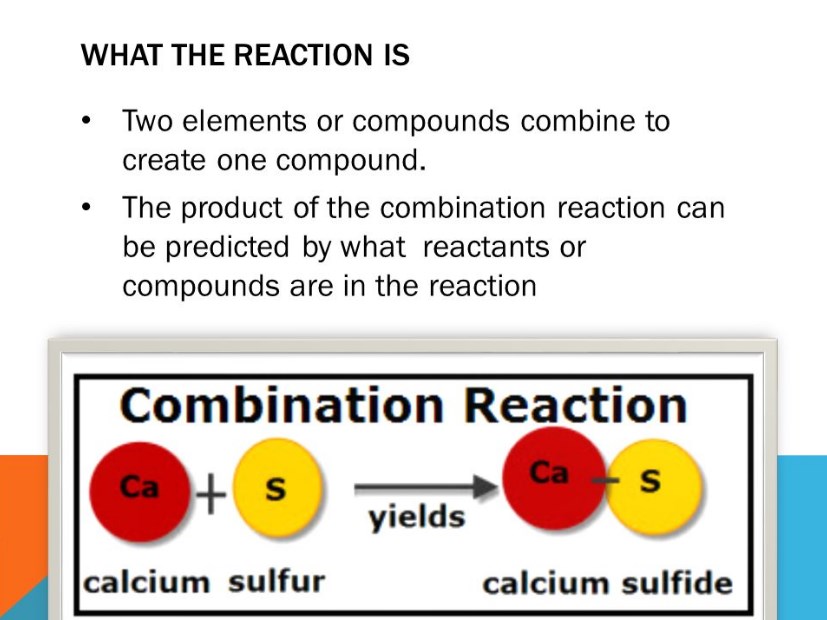Combination Reaction
A combination reaction also recognized as a synthesis reaction, is a reaction where two or more elements or compounds (reactants) merge to form a single compound (product). Such reactions are represented by equations of the subsequent form: X + Y → XY. The combination of two or more elements to construct one compound is named a combination reaction. In alternative words, when two or more elements or compounds react so as to construct one single compound, then the chemical reaction that takes place is hailed a combination reaction.
- Between elements C + O2 → CO2. Carbon finally burnt in oxygen yields carbon dioxide.
- Between compounds CaO + H2O → Ca(OH)2. Calcium oxide (lime) mixed with water gives calcium hydroxide (slaked lime).
- Between elements and compounds 2CO + O2 → 2CO2. Oxygen combines with carbon monoxide, And carbon dioxide is formed.
There is no definitive number of reactants in a combination reaction.
What is a Combination Reaction?
A combination reaction is a reaction in which two or more reactants chemically bond and merge to form a product. A synthesis reaction is also familiar with a combination reaction. Most synthesis reactions are exothermic reactions, i.e., heat is removed during the reaction.

General Equation
The normal chemical equation for a synthesis reaction is given by the following equation.
A + B → AB
When creating an actual reaction, the reaction must be balanced.
What are the types of combination reactions?
Combination reactions are of three types.
Similarly, non-metals may perform with highly active metals to form covalent compounds. For example, sulphur reacts with oxygen gas to form gaseous sulphur dioxide
1.The reaction between two or more elements:
An example of this type of combination reaction is the reaction between a metal and a non-metal. Most metals react with non-metals to form ionic compounds. A good example of this would be:
2. The reaction between elements and compounds:
An element and a compound react to form another compound. For example, carbon monoxide reacts with oxygen gas to form carbon dioxide.
3. The reaction between two compounds:
Two compounds react with each other to form a new compound. For example, calcium oxide (quick lime) reacts with carbon dioxide gas to form calcium carbonate (limestone).
Most combination reactions are exothermic in nature. Why?
Combination reactions commit the formation of new bonds and this process releases a large amount of energy in the form of heat.
Let us consider some more examples of combination reactions.
- Formation of Calcium Hydroxide: Reaction between quick lime (Calcium oxide, CaO) and water is a combination reaction. In this reaction, quick lime reacts with water to compose slaked lime (calcium hydroxide, Ca(OH)2). The reaction between quick lime and water is eminently vigorous as well as exothermic.
- Combustion Reactions: Combustion of coal and combustion of hydrogen are illustrations of combination reactions. Coal burns in the air to form carbon dioxide gas.
- Hydrogen burns in the existence of oxygen to form water in the form of steam. Upon cooling, it becomes liquid.
- Formation of Ammonium chloride: Ammonium chloride is formed by combining vapours of ammonia with hydrogen chloride gas. It is a white-coloured solid.
- Formation of Sulphuric acid: The formation of sulphuric acid from sulphur trioxide is also a combination reaction. Sulphur trioxide on hydration forms sulphuric acid. This reaction is highly exothermic in nature.
- Formation of ferrous sulphide: It is formed by heating fine pieces of iron with sulphur powder.
- Manufacture of Ammonia: The manufacture of ammonia gas from nitrogen and oxygen is also a combination reaction.
- Combination of sodium oxide and water: Sodium oxide combines with water to form sodium hydroxide.
Examples of Synthesis Reactions in Everyday Life
There are a few examples of the synthesis reaction in real and daily life. Almost all real-life examples are seen in the industry. During industrial manufacturing, the synthesis reaction forms a significant part in the synthesis of new compounds.
- Synthesis of ammonia
- Commercial production of slaked lime (calcium hydroxide)
- Production of sodium chloride or common salt
- Preparation of hydrochloric acid and ammonium chloride
- Other examples include: Rusting, Photosynthesis
Conclusion
- Students achieve knowledge about combination reactions.
- Students achieve skills to perform a combination reaction using quick lime and water.
- Students will be able to distinguish a combination reaction from a given set of chemical reactions.
Comments
Post a Comment